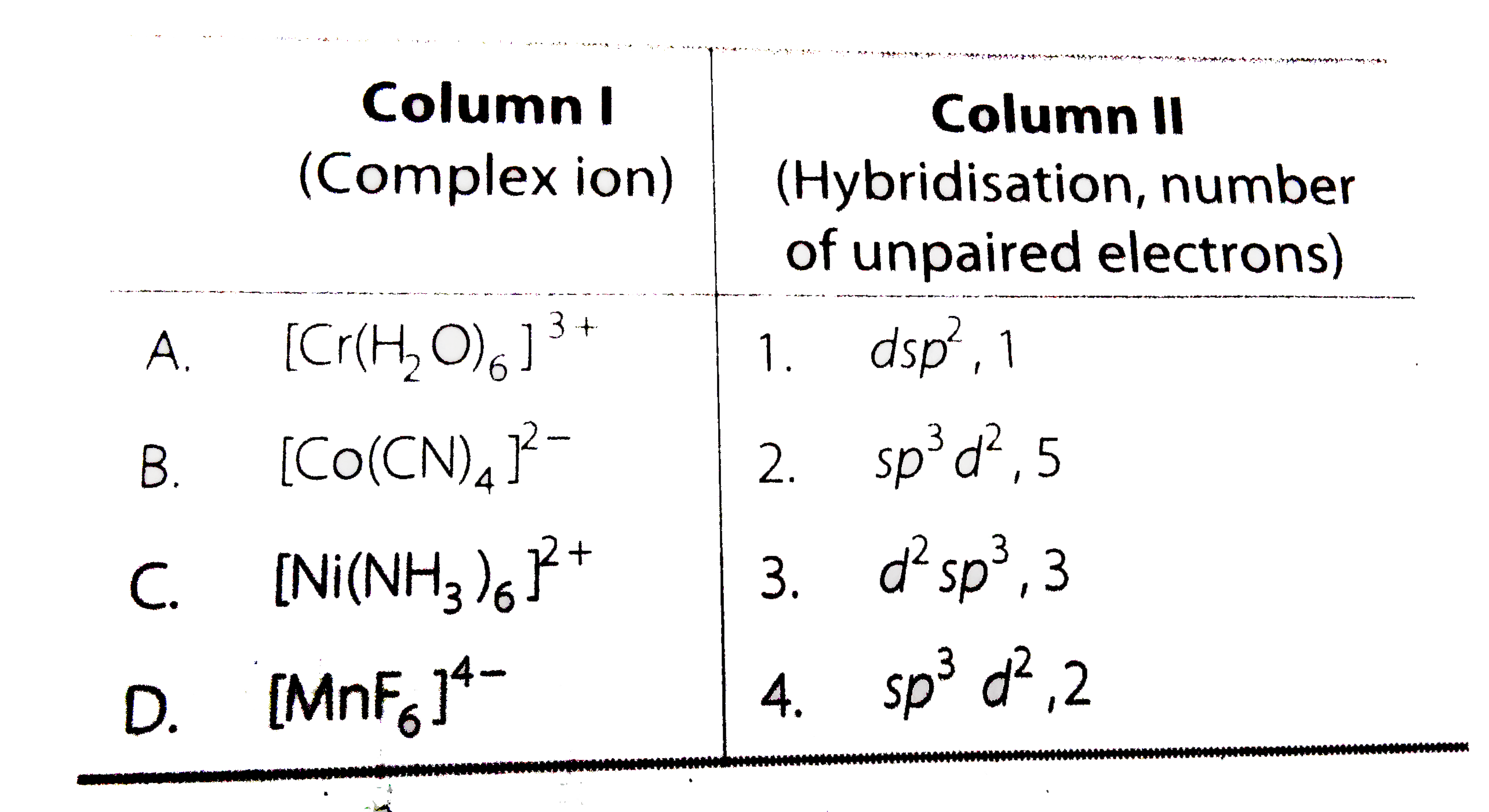The hybridisation and unpaired electrons in [Fe(H2O)2+6] ion are :
sp3d2,4
d2sp3,3
d2sp3,4
sp3d2,2
The correct Answer is:A
To determine the hybridization and the number of unpaired electrons in the complex ion (Fe(H2O)6)2+, we can follow these steps:
Step 1: Determine the oxidation state of Iron (Fe)
The complex ion has a charge of +2. The water molecules are neutral ligands, contributing 0 charge. Let the oxidation state of iron be x.
x+6(0)=+2⟹x=+2
Step 2: Write the electron configuration of Iron in the +2 oxidation state
Iron has an atomic number of 26. The electron configuration of neutral iron is:
(Ar)4s23d6
When iron loses 2 electrons to form Fe2+, the configuration becomes:
(Ar)3d6
Step 3: Determine the geometry and coordination number
The complex (Fe(H2O)6)2+ has a coordination number of 6, which indicates an octahedral geometry.
Step 4: Understand the splitting of d-orbitals in octahedral complexes
In an octahedral field, the d orbitals split into two sets: t2g (lower energy) and eg (higher energy). For d6 configuration in a weak field ligand like water, we expect a high-spin configuration.
Step 5: Fill the d-orbitals according to Hund's rule
Since water is a weak field ligand, it does not cause pairing of electrons. Thus, the d orbitals will be filled as follows:
- The t2g orbitals will be filled first, followed by the eg orbitals.
- The filling will look like this:
- t2g: 3 electrons (1 in each orbital)
- eg: 3 electrons (1 in each orbital)
This results in the following arrangement:
t2g:↑↑↑eg:↑↑
Step 6: Count the number of unpaired electrons
From the arrangement above, we can see that there are 4 unpaired electrons (3 in t2g and 1 in eg).
Step 7: Determine the hybridization
In an octahedral complex, the hybridization is sp3d2 because it involves the mixing of one s, three p, and two d orbitals.
Final Answer
The hybridization and the number of unpaired electrons in (Fe(H2O)6)2+ are:
Hybridization: sp3d2,Unpaired Electrons: 4
---
The complex ion has a charge of +2. The water molecules are neutral ligands, contributing 0 charge. Let the oxidation state of iron be x.
Iron has an atomic number of 26. The electron configuration of neutral iron is:
The complex (Fe(H2O)6)2+ has a coordination number of 6, which indicates an octahedral geometry.
In an octahedral field, the d orbitals split into two sets: t2g (lower energy) and eg (higher energy). For d6 configuration in a weak field ligand like water, we expect a high-spin configuration.
Since water is a weak field ligand, it does not cause pairing of electrons. Thus, the d orbitals will be filled as follows:
- The filling will look like this:
- t2g: 3 electrons (1 in each orbital)
- eg: 3 electrons (1 in each orbital)
From the arrangement above, we can see that there are 4 unpaired electrons (3 in t2g and 1 in eg).
In an octahedral complex, the hybridization is sp3d2 because it involves the mixing of one s, three p, and two d orbitals.
The hybridization and the number of unpaired electrons in (Fe(H2O)6)2+ are:
Topper's Solved these Questions
- COORDINATION COMPOUNDSBOOK - RESONANCE ENGLISHCHAPTER - COORDINATION COMPOUNDSEXERCISE - Exercise Part-II: Section (F)
2 Videos
- COORDINATION COMPOUNDSBOOK - RESONANCE ENGLISHCHAPTER - COORDINATION COMPOUNDSEXERCISE - Exercise Part-II: Section (G)
6 Videos
- COORDINATION COMPOUNDSBOOK - RESONANCE ENGLISHCHAPTER - COORDINATION COMPOUNDSEXERCISE - Exercise Part-II: Section (D)
5 Videos
- CHEMISTRY IN EVERYDAY LIFEBOOK - RESONANCE ENGLISHCHAPTER - CHEMISTRY IN EVERYDAY LIFEEXERCISE - ORGANIC CHEMISTRY(Chemistry in every day life)
31 Videos
- D & F BLOCK ELEMENTSBOOK - RESONANCE ENGLISHCHAPTER - D & F BLOCK ELEMENTSEXERCISE - ORGANIC CHEMISTRY(Aldehydes , Ketones, Carboxylic acid)
15 Videos
Similar Questions
Knowledge Check
Assertion : [Fe(H2O)6]2+ is sp3d2 hybridised and paramagnetic complex ion .
Reason : [Fe(H2O)6]2+ has four unpaired electrons as H2O is a weak field ligand .AIf both Assertion and reason are true and reason is the correct explanation of assertionBIf both assertion and reason are true but reason is not the correct explanation of assertionCIf assertion is true but reason is falseDif both assertion and reason are false
Number of unpaired electrons present in[Ni(H2O)6]3+
View SolutionPredict the number of unpaired electrons in [Cr(H2O)6]2+
View SolutionThe number of unpaired electrons in Fe3+ ion are
View SolutionWith the help of crystal field theory, predict the number of unpaired electrons in [Fe(H2O)6]2+
View SolutionCalculate the number of unpaired electrons in [Mn(H2O)6]2+ , Considering H2O as a weak field ligand (At . No of Mn = 25 )
View SolutionMatch the complex ions given in column I with the hybridisation and number of unpaired electrons given in column II and assign the correct code

View SolutionNumber of unpaired electrons in Fe3+ (Z = 26) is
View Solution
